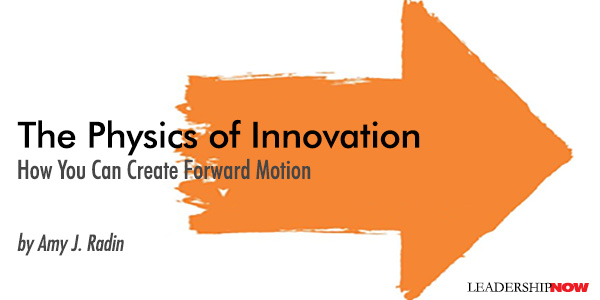 |
 |
09.05.18

The Physics of Innovation
A What we were taught in high school science, F = MA, force = mass times acceleration, also describes the physics of innovation. The laws of innovation may be an entirely different application than Newton intended, but tracking through on the metaphor yields pragmatic tips for innovators. Innovation faces the inertia of the status quo defined by team members, organization culture, and whatever product or service solutions already exist. These all become anchors for evaluating the desirability of anything new. Every member of a team in any organization brings with them some version of “the way things have always been done.” Users have ways they are solving the problems innovations claim to address. Change makers – whether corporate innovators, founders, or investors – improve their odds of moving their ideas from napkin back and prototype to commercial reality at scale when they acknowledge that one of their biggest challenges is overcoming the bias to maintain things as they are. How can change makers create the forward motion to dilute the impact of inertia so they can advance innovation? Here are four imperatives based upon the physics of innovation: Know and convey your purpose. Purpose is not about a slogan on the conference room wall. It’s about knowing what you stand for, why your enterprise exists, and why you are there. With purpose backed by passion and commitment, you can challenge and motivate yourself and others to accomplish hard goals. Purpose creates the fuel – the intensity – required to change the status quo of what is, towards the change maker’s view of what is possible. Chunk down whatever you are trying to create into small steps. By bringing people with different perspectives together to iterate ever-improving prototypes, and exposing the prototypes to users at each step, the change maker accomplishes key objectives: Collaboration and inclusion build buy-in as people feel heard and are able to contribute their expertise. Costly mistakes are avoided as innovations that are true departures from the status quo evoke counter-intuitive responses – good and bad. And, iteration feeds the next item on this list -- speed. Move fast. Taking multiple steps to iterate a prototype before declaring readiness to go to market may feel like a slowdown. But in fact, chunking down the work into iterative cycles can compress the time it takes to get to market with a product or service that works, and that people really want to own and use. Imagine the difference between a fully unfurled piece of string, and one of the same length compressed into a coil. The two strings represent the difference between the start and end times for a linear approach versus one that is iterative. Follow the ‘compliment then complement’ principle. Some amount of resistance to innovation happens when people tied to a prior success see the next big thing as a repudiation of their past contributions. Take the edge off this emotional impulse by signaling respect and empathy with a simple practice: Compliment with an ‘i’ then complement with an ‘e’. Here’s an example of how this sounds, in the case of introducing client segmentation to insurance agents accustomed to mining their contact lists one-at-a-time for leads: “You have done an amazing job within your network identifying new clients. We can offer you a new tool to try out that might allow you to achieve even better results by tagging your contacts with a segment identifier. Others are finding this is helping them to win new business.”  Follow Amy on Twitter and LinkedIn. You can download an excerpt of The Change Maker’s Playbook on her website.
Posted by Michael McKinney at 09:07 AM
|
BUILD YOUR KNOWLEDGE
 

How to Do Your Start-Up Right STRAIGHT TALK FOR START-UPS 
Grow Your Leadership Skills NEW AND UPCOMING LEADERSHIP BOOKS 
Leadership Minute BITE-SIZE CONCEPTS YOU CAN CHEW ON 
Classic Leadership Books BOOKS TO READ BEFORE YOU LEAD |